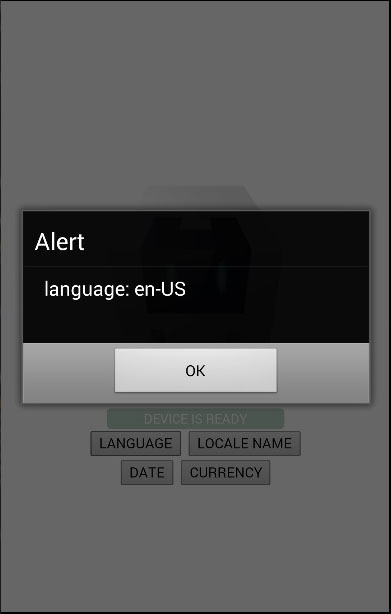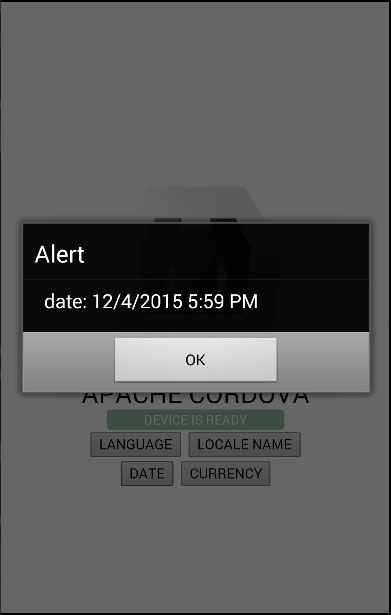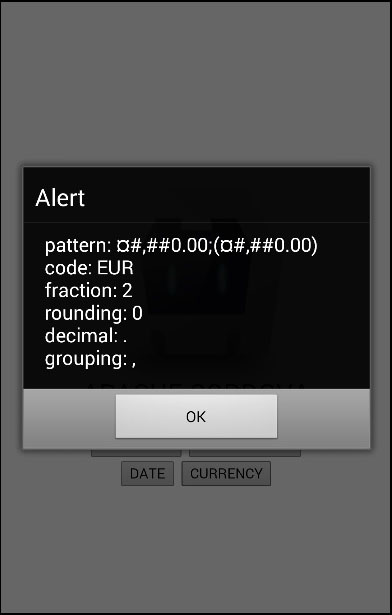这个插件是用于获取关于用户区域设置语言,日期和时区,货币等的信息。
第1步- 安装全球化插件
打开命令提示符窗口,键入如下所示的代码来安装这个插件。
C:\Users\username\Desktop\CordovaProject>cordova plugin add cordova-plugin-globalization
第2步 - 添加按钮
这里需要添加几个按钮的index.html才能够调用,我们将在稍后创建不同的方法。
<button id = "getLanguage">LANGUAGE</button> <button id = "getLocaleName">LOCALE NAME</button> <button id = "getDate">DATE</button> <button id = "getCurrency">CURRENCY</button>
第3步 - 添加事件监听器
事件侦听器将被添加到index.js文件的DeviceReady函数里面,以确保我们开始使用它之前,应用程序被Cordova 加载。
document.getElementById("getLanguage").addEventListener("click", getLanguage);
document.getElementById("getLocaleName").addEventListener("click", getLocaleName);
document.getElementById("getDate").addEventListener("click", getDate);
document.getElementById("getCurrency").addEventListener("click", getCurrency);
步骤4A - 语言函数
我们使用第一个函数返回户端设备的BCP客47语言标记。这里使用的是 getPreferredLanguage 方法. 该函数有两个参数:onSuccess和onError。我们在 index.js 中使用此函数。
function getLanguage() {
navigator.globalization.getPreferredLanguage(onSuccess, onError);
function onSuccess(language) {
alert('language: ' + language.value + '\n');
}
function onError(){
alert('Error getting language');
}
}
当我们按 LANGUAGE 按钮,弹出框就会显示在屏幕上。


步骤4B - 区域设置函数
该函数返回客户端的区域设置的 BCP 47标记。此函数和我们之前创建的相似。唯一的区别是,我们这次使用的是 getLocaleName 方法。
function getLocaleName() {
navigator.globalization.getLocaleName(onSuccess, onError);
function onSuccess(locale) {
alert('locale: ' + locale.value);
}
function onError(){
alert('Error getting locale');
}
}
当我们点击LOCALE按钮,弹出框将显示我们的区域标记。


步骤4C - Date函数
此功能用于根据用户的语言环境和时区设置返回日期。date 参数是当前日期以及 options参数是可选的。
function getDate() {
var date = new Date();
var options = {
formatLength:'short',
selector:'date and time'
}
navigator.globalization.dateToString(date, onSuccess, onError, options);
function onSuccess(date) {
alert('date: ' + date.value);
}
function onError(){
alert('Error getting dateString');
}
}
现在,我们运行应用程序,并按下DATE 按钮来看当前的日期。


最后一个函数功能,将是根据客户设备的设置和 ISO4217 货币代码返回货币值。
function getCurrency() {
var currencyCode = 'EUR';
navigator.globalization.getCurrencyPattern(currencyCode, onSuccess, onError);
function onSuccess(pattern) {
alert('pattern: ' + pattern.pattern + '\n' +
'code: ' + pattern.code + '\n' +
'fraction: ' + pattern.fraction + '\n' +
'rounding: ' + pattern.rounding + '\n' +
'decimal: ' + pattern.decimal + '\n' +
'grouping: ' + pattern.grouping);
}
function onError(){
alert('Error getting pattern');
}
}
当点击 CURRENCY 按钮会触发弹出框,显示用户的货币模式。


这个插件提供了其他方法。可以看到如下面的表中。
| 方法 | 参数 | 描述 |
|---|---|---|
| getPreferredLanguage | onSuccess, onError |
返回客户端的当前语言
|
| getLocaleName | onSuccess, onError |
返回客户端的当前区域设置
|
| dateToString | date, onSuccess, onError, options |
根据客户的语言环境和时区返回日期
|
| stringToDate | dateString, onSuccess, onError, options |
根据客户的设置解析日期
|
| getCurrencyPattern | currencyCode, onSuccess, onError |
返回客户端的货币模式
|
| getDatePattern | onSuccess, onError, options |
返回客户端的日期模式
|
| getDateNames | onSuccess, onError, options |
返回根据客户设置几个月份,几个星期甚至几天的名称数组
|
| isDayLightSavingsTime | date, successCallback, errorCallback |
用于确定是否夏令时根据客户的时区和日历处于活动状态
|
| getFirstDayOfWeek | onSuccess, onError |
根据客户端设置返回一周的第一天
|
| numberToString | number, onSuccess, onError, options |
根据客户端的设置返回数值
|
| stringToNumber | string, onSuccess, onError, options |
根据客户端设置解析一个数值
|
| getNumberPattern | onSuccess, onError, options |
根据客户端的设置,返回数值的模式
|
上一篇:
Cordova地理位置
下一篇:
Cordova InAppBrowser打开Web浏览器
